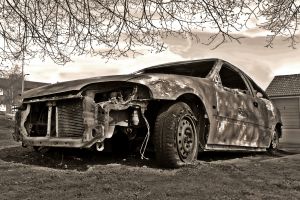
What thought pops into mind upon seeing this picture? credit - http://www.sxc.hu/home
Is it associated with the Middle East? It was my thought, immediately upon seeing this stark image. As it turns out, it was taken in London. Surprised?
Photos similar to this one are etched in thousands of minds because they are often the realities of a news day. Modern newspapers depend heavily on photojournalists as well as writers to provide news coverage. Narrative alone will not satisfy today's readers. Automatic associations, emotions and assumptions occur as we look at such images. And photojournalists are well aware of this. Outstanding photographers are very good at capturing an event that is hot in the news.
Continuing the car theme, there is something about images of cars in trouble that seems to symbolize people in trouble. We value our cars and many of us fear "being afoot." Having transportation can be the difference between life and death in some cases. So using cars as suicide bombs, losing cars in hurricanes, or deliberately setting cars on fire in protest is a very big deal. For example:
- A Southwestern photojournalist/blogger, Mark Hancock, is someone whose work I admire. Mark's car photo taken after Hurricane Rita initiates the "Mark-O-Rita" section of his blog. Coincidentally he just happens to be the husband of one of my favorite bloggers, Fayrouz Hancock, herself an excellent photographer. Together, they went through Hurricane Rita in Beaumont where they live and work.
- "Hugo" at Flikr captured a burning car on the streets of Paris during the February 2006 youth protests against CPE. A hat tip to rebecca's pocket for the link.
- Photographs taken by two more Southwest photojournalists, David Leeson and Cheryl Diaz Meyer of the Dallas Morning News won the 2004 Pulitzer Prize for "Breaking News Photography." The first photo in their portfolio is a burning car image from the Iraq war.
Closing with a last picture with a car as part of the image, is this photojournalism tribute by Kenny Irby at Poynteronline to the late Gordon Parks, Photojournalist Extraordinaire, who passed away earlier this year. I quote from his article,
Since the age of 11, I've wanted to be a "picture man," and Parks was always one of my idols.Those who read my blogs notice that almost all of them begin with an image of some sort. It is my first "statement" in the piece. I am an amateur photographer, who has yet to go digital, hwoever, so almost all of these images are legally borrowed. This TPM Cafe post by slb - "Respecting Copyright," with its resulting thread, is what got me to thinking about photographs as intellectual property of immense value. So today I honor the photojournalist - with all proper links, I hope, slb, and with a title link to Wikipedia above.
I learned about F-stops and shutter speed, darkroom printing and composition from Walter M. Bryant and Llewellyn Berry in the District of Columbia public school system.
But I learned from Parks about the power of cameras as a weapon against injustice.
He rose from extreme poverty and segregation in Fort Scott, Kansas, to become one of the nation's most distinguished artistic and journalistic icons.
Parks documented the tribulations and triumphs of black America as a photojournalist for the Farm Security Administration (FSA), Life magazine and Vogue, before becoming Hollywood's first major black artist to produce and direct a film in 1969 with "The Learning Tree." He went on to direct the hit "Shaft" and the sequel "Shaft's Big Score" in 1971 and 1972 respectively.
Tags: photojournalism In the news Iraq blogging media news news and politics photography photos cars
No comments:
Post a Comment